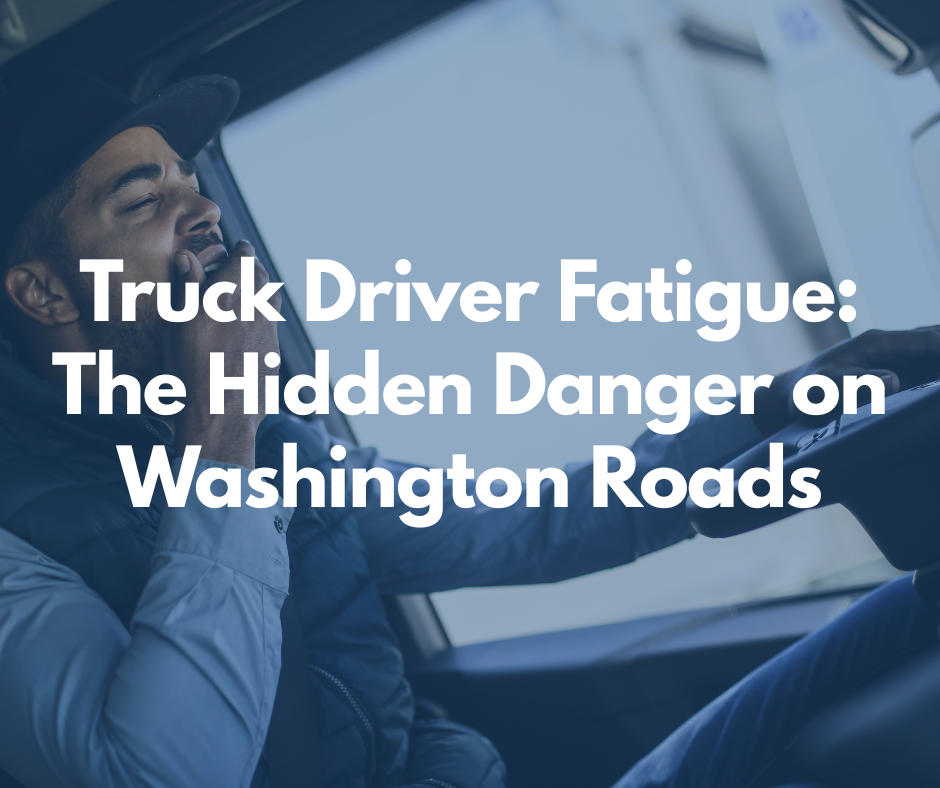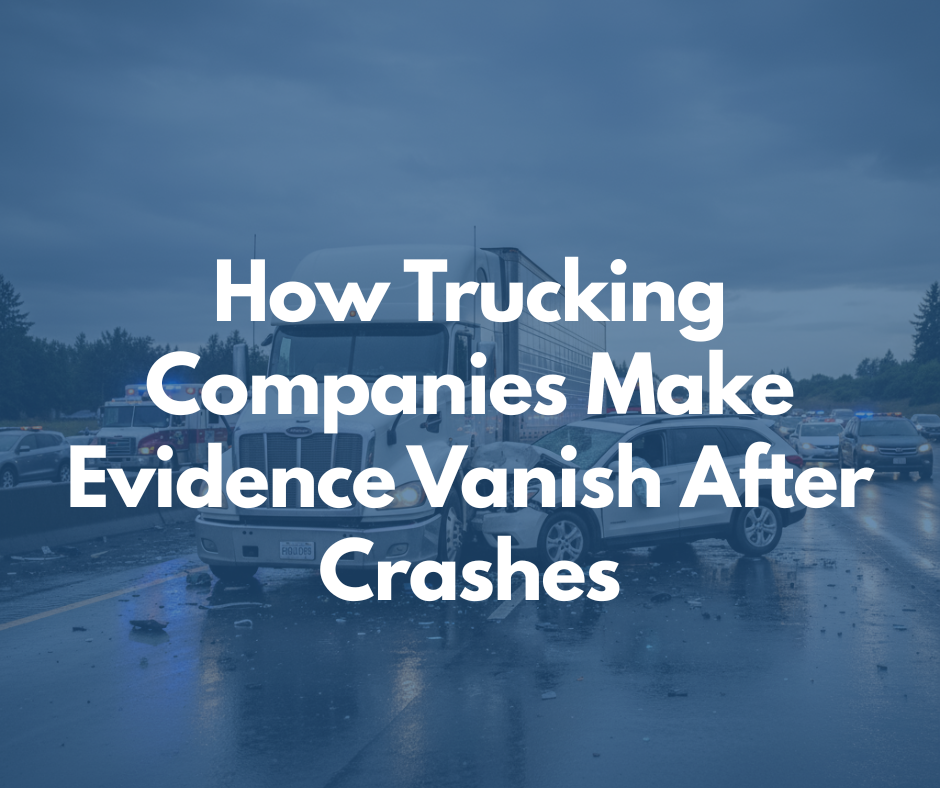
TL;DR - Key Takeaways:
- Common truck accident types include jackknife collisions (10% of crashes), rollover accidents (5% but disproportionately fatal), rear-end impacts (22%), underride crashes, blind spot incidents (one-third of truck-car collisions), and lost load accidents.
- Truck stopping distances are up to 40% greater than passenger vehicles, with rear-end collisions often resulting from driver distraction, traffic congestion, or inability to brake quickly enough for changing conditions.
- FMCSA cargo securement regulations require adequate tie-down systems, minimum working load limits of half the cargo weight, proper blocking and bracing, and mandatory inspections within 50 miles and every 3 hours or 150 miles.
- Primary accident causes include driver fatigue from demanding schedules, mechanical failures from inadequate maintenance, environmental factors like adverse weather, and human errors such as ignoring traffic signals at intersections.
- Victims face complex legal challenges involving trucking regulations, multiple liability parties, and insurance negotiations, requiring specialized truck accident attorneys to investigate scenes, preserve evidence, and secure appropriate compensation.
The team at Metier Law Firm Truck Crash Lawyers knows that the intricate network of highways that crisscross the United States serves as the lifeblood of its economy, facilitating the seamless transport of goods and bolstering commerce. Integral to this logistical prowess are the legions of tractor-trailers and 18-wheeler trucks that traverse these roads daily. While these vehicles are indispensable to the nation's economic health, their sheer size and the volume of traffic they contribute to the roadway significantly elevates the risk of accidents. These incidents, characterized by their complexity and the severe outcomes they often entail, underscore a pressing need for awareness and preventative measures.

Our legal practice, steeped in years of specializing in truck accident law, has afforded us a unique perspective on the havoc these accidents can wreak. This guide aims to dissect the common types of truck accidents, delving into their causes, the aftermath for those involved, and the legal recourse available. Our objective is not only to illuminate the risks inherent to sharing the road with these commercial behemoths but also to offer solace and guidance to those ensnared in the aftermath of such tragedies.
Types of Truck Accidents and Their Implications
Jackknife Accidents
The term "jackknife" is derived from the acute angle that forms between the trailer and the cab when the former swings outwards during a sudden braking maneuver or when negotiating slippery road conditions. These accidents can lead to multi-vehicle pile-ups, presenting significant dangers to all road users in the vicinity.
According to the Federal Motor Carrier Safety Administration (FMCSA), jackknife accidents constitute approximately 10% of all trucking accidents.
In 2018, a jackknife accident on Interstate 95 caused a massive pile-up involving four vehicles. The truck driver lost control on a wet road, leading to the trailer swinging out and blocking multiple lanes. “It’s a driver’s nightmare because once it starts it is almost impossible to control,” shares Mike Chaloupka, a seasoned truck accident lawyer at Metier Law Firm. Preparing for poor road conditions is a truck driver’s responsibility. Failure to take precautions can result in severe injuries to drivers on the road.
Rollover Accidents
Rollovers are triggered by a variety of factors, including excessive speed, improper cargo loading, abrupt turns, or losing control on slick surfaces. The consequences are often dire, with the potential for grave injuries or fatalities, not to mention the substantial road blockages they cause.
Rollover accidents account for about 5% of all large truck crashes but are responsible for a disproportionately high number of fatalities.
A notable rollover occurred in Texas in 2017 when a truck carrying a heavy load took a turn too quickly, tipping over and crushing a passenger car, resulting in three fatalities. “Rollover accidents are frequently linked to improperly secured loads or excessive speeds. The physics of these large vehicles means that once they start to tip, the outcome is often disastrous," explains Managing Partner Chaloupka.
Rear-End Collisions
Attributable to the long braking distances required by heavy trucks, rear-end collisions are a frequent outcome of congested traffic conditions, driver distraction, or the inability to adjust speed promptly. The occupants of the vehicle in front bear the brunt of the impact, facing severe risk of injury or death.
.png)
The National Highway Traffic Safety Administration (NHTSA) finds that rear-end collisions make up 22% of all truck accidents, highlighting the challenges trucks have in stopping quickly.
According to industry experts, the stopping distance for a fully loaded truck can be up to 40% greater than that of a passenger vehicle. Even with the best intentions, physics won't allow a truck to stop on a dime.
Underride Accidents
Among the most catastrophic collision types, underride accidents occur when a smaller vehicle becomes lodged beneath a truck's trailer. These incidents often result in fatal outcomes, highlighting the critical importance of underride guards and heightened awareness on the part of all drivers.
Underride accidents can occur when a truck enters the highway from an on-ramp or makes a turn in the middle of the roadway. “Underride guards are crucial for preventing these types of accidents, but even the best guards can fail in high-speed impacts," says truck accident attorney Mike Chaloupka.
Blind Spot Accidents
Trucks have large blind spots that can obscure the presence of other vehicles. Accidents resulting from lane changes or turns made without full visibility are common, stressing the need for vigilance, driver training and the use of technology to mitigate these risks.
According to the FMCSA, one-third of all crashes between large trucks and cars occur in a truck's blind spot. Over the years, our truck accident attorneys have helped many victims of blind spot accidents with heavy trucks. Often times the driver has not been properly trained to be aware of the No-Zones. It is critical to have an experience truck accident lawyer on your side to establish liability and find sufficient insurance.
Lost Load Accidents
Inadequately secured cargo poses a significant hazard when it falls onto the roadway, leading to collisions or causing drivers to swerve unpredictably. The responsibility for securing loads properly lies squarely with the trucking operators and drivers.
According to the FMCSA the key requirements a truck drivers must follow to secure a load include:
Use of Adequate Securement Systems that might include ties, straps, chains, bars and blocks, among others. These systems must be able to withstand a minimum amount of force in various directions (forward, rearward, sideways, and vertically) without failing.
Minimum Working Load Limit: The aggregate working load limit of the securement system must be at least one-half of the weight of the cargo being secured. The working load limit is the maximum load that can be applied to the component of the cargo securement system during normal service.
Proper Blocking and Bracing: Cargo must be adequately blocked, braced, or immobilized to prevent movement during transport. This could involve using dunnage bags, shoring bars, wedges, and other means to fill voids and secure the cargo in place.

Securement of All Cargo: Regardless of its size, type, or where it is placed on the vehicle, all cargo must be secured to prevent movement or loss during transit. This includes ensuring that cargo cannot roll, shift, slide, or otherwise move to compromise the stability or maneuverability of the vehicle.
Periodic Inspection and Adjustment: Drivers are required to inspect their cargo and the securing devices within the first 50 miles of a trip and make any necessary adjustments. Cargo must be re-inspected and adjusted as necessary at every change of duty status, and after driving for three hours or 150 miles, whichever comes first.
Use of Edge Protection: When necessary, edge protection must be used to prevent securement devices from cutting into the cargo. This is particularly important for items with sharp edges that could slice through straps or other securing devices.
Compliance with Specific Requirements for Certain Types of Cargo: The FMCSA provides detailed requirements for specific types of cargo, such as logs, metal coils, paper rolls, concrete pipes, intermodal containers, automobiles, heavy vehicles, and flattened or crushed vehicles. These specific requirements address the unique challenges posed by each type of cargo.
Head-On Collisions
Though less frequent, head-on collisions with trucks are invariably severe, often resulting from driving against traffic, fatigue-induced errors, or impaired driving. The force of impact in such cases is devastating, making survival unlikely.
“It is crucial for heavy truck drivers to manage their fatigue and for trucking companies to enforce driving hour regulations strictly,” says Mr. Chaloupka. All too often, truck drivers are pushed to meet delivery deadlines, resulting in head-on collisions after falling asleep at the wheel.
T-Bone Accidents
Occurring predominantly at intersections, T-bone or side-impact collisions involve the side of a truck being struck by another vehicle. These accidents are typically the result of ignored traffic signals or failure to yield, with particularly severe consequences for the passengers of the impacted vehicle.
Among other safe driving practices, proper use of mirrors and turn signals is crucial for safely navigating intersections, allowing other road users to understand a trucker's intentions. While not specified for intersections alone, these practices are part of the safe driving behavior expected from CMV operators.

Exploring the Causes and Consequences
The underlying causes of truck accidents are multifaceted, ranging from human error and mechanical failures to environmental factors. Driver fatigue, a pervasive issue within the trucking industry, stems from grueling schedules and insufficient rest. Mechanical failures, meanwhile, can be traced back to lax maintenance practices or inherent vehicle defects, underscoring the necessity of regular inspections and adherence to safety standards.
Environmental conditions, such as adverse weather and hazardous roadways, further compound these risks. The complexity of navigating a large truck under such circumstances cannot be overstated, necessitating additional caution and, at times, the difficult decision to halt operations until conditions improve.
The aftermath of truck accidents is often characterized by a chaotic scramble for accountability, with victims grappling with physical injuries, emotional trauma, and financial burdens. The path to recovery is fraught with challenges, from securing adequate medical care to navigating the intricacies of legal claims for compensation.
Navigating the Legal Landscape
Victims of truck accidents are thrust into a legal arena that is as complex as it is daunting. The pursuit of justice and compensation demands a nuanced understanding of trucking regulations, liability laws, and the intricacies of insurance policies. It is a domain where experienced legal counsel becomes not just beneficial but essential.
Our firm stands at the forefront of this battle, advocating for the rights of those affected by truck accidents. We delve into each case with a meticulousness borne of our commitment to securing the best possible outcome for our clients. From investigating the accident scene to negotiating with insurance companies and, if necessary, litigating in court, our approach is comprehensive and relentless.
A Call to Action
The road to making our highways safer for everyone is long and requires the collective effort of trucking companies, regulatory bodies, drivers, and the public at large. It involves not only adherence to existing safety regulations but also a commitment to fostering a culture of vigilance and responsibility.
For those who have suffered as a result of a truck accident, remember that you are not alone. Legal avenues exist to redress the harm done, and specialized attorneys are here to guide you through the process. If you find yourself or a loved one in such a predicament, we urge you to reach out for a consultation. Together, we can navigate the aftermath of the accident and work towards a resolution that acknowledges your suffering and facilitates your journey towards healing.
In closing, the significance of understanding the common types of truck accidents transcends mere academic interest. It is a matter of public safety, of preventing future tragedies, and ensuring that those who have already endured such misfortunes receive the support and compensation they rightfully deserve. Our commitment to this cause is unwavering, and we stand ready to assist those in need with the full weight of our expertise and resources.
If you've been involved in a collision with a semi truck or other large commercial vehicle, call the experienced team of truck accident attorneys at Metier Law Firm today at 866-377-3800 or visit us online to schedule your free and confidential consultation at metierlaw.com.
Tell Us About Your Case – Free Case Review with a Truck Accident Lawyer
Tell Us About Your Case – Free Case Review with a Personal Injury Lawyer
(866) 377-3800Our Locations
.webp)
Do I have a Case?
How Much Should I Be Offered?
Do I Need an Attorney?
If these questions have crossed your mind, let us help. You may need a little direction or may not need an attorney at all, but you deserve to be confident knowing your options. We can provide you with information about our Attorneys of the West® accident investigations and legal services. Your confidential consultation with us is totally free.
Keep up with us!

.svg)




